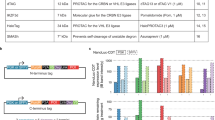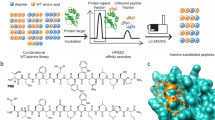Abstract
Many biological processes rely on protein–protein interactions. These processes include signal transduction, cell cycle regulation, gene regulation, and viral assembly and replication. Moreover, many proteins and enzymes manifest their function as oligomers. We describe here an efficient means to sift through large combinatorial libraries and identify molecules that block the interaction of target proteins in vivo. The power of this approach is demonstrated by the identification of nine-residue peptides from a combinatorial library that inhibit the intracellular dimerization of HIV-1 protease. Fewer than 1 in 106 peptides do so. In vitro biochemical analyses of one such peptide demonstrate that it acts by dissociating HIV-1 protease into monomers, which are inactive catalysts. Inhibition is enhanced further by dimerizing the peptide. This approach enables the facile identification of new molecules that control cellular processes.
This is a preview of subscription content, access via your institution
Access options
Subscribe to this journal
Receive 12 print issues and online access
$209.00 per year
only $17.42 per issue
Buy this article
- Purchase on Springer Link
- Instant access to full article PDF
Prices may be subject to local taxes which are calculated during checkout



Similar content being viewed by others
References
Smith G.P. Filamentous fusion phage: novel expression vectors that display cloned antigens on the virion surface. Science 228, 1315 (1985).
Matthews, D.J. & Wells, J.A. Substrate phage: selection of protease substrates by monovalent phage display. Science 260, 1113–1117 (1993).
Fields, S. & Song, O. A novel genetic system to detect protein–protein interactions. Nature 340, 245–246 (1989).
Chien, C.-T., Bartel, P.L., Sternglanz, R. & Fields, S. The two-hybrid system: a method to identify and clone genes for proteins that interact with a protein of interest. Proc. Natl. Acad. Sci. USA 88, 9578–9582 (1991).
Geyer, C.R., Colman-Lerner, A. & Brent, R. “Mutagenesis” by peptide aptamers identifies genetic network members and pathway connections. Proc. Natl. Acad. Sci. USA 96, 8567–8572 (1999).
Norman, T.C. et al. Genetic selection of peptide inhibitors of biological pathways. Science 285, 591–595 (1999).
Zutshi, R., Brickner, M. & Chmielewski, J. Inhibiting the assembly of protein–protein interfaces. Curr. Opin. Chem. Biol. 2, 62–66 (1998).
Kohl, N.E. et al. Active human immunodeficiency virus protease is required for viral infectivity. Proc. Natl. Acad. Sci. USA 85, 4686–4690 (1988).
Peng, C., Ho, B.K., Chang, T.W. & Chang, N.T. Role of human immunodeficiency virus type 1-specific protease in core protein maturation and viral infectivity. J. Virol. 63, 2550–2556 (1989).
Flexner, C. HIV-protease inhibitors. N. Engl. J. Med. 338, 1281–1292 (1998).
Wlodawer, A. & Vondrasek, J. Inhibitors of HIV-1 protease: A major success of structure-assisted drug design. Annu. Rev. Biophys. Biomol. Struct. 27: 249–284.
Lebon, F. & Ledecq, M. 2000. Approaches to the design of effective HIV-1 protease inhibitors. Curr. Med. Chem. 7, 455–477 (1998).
Klabe, R.M., Bacheler, L.T., Ala, P.J., Erickson-Viitanen, S. & Meek, J.L. Resistance to HIV protease inhibitors: a comparison of enzyme inhibition and antiviral potency. Biochemistry 37, 8735–8742 (1998).
Schramm, H.J., Nakashima, H., Schramm, W., Wakayama, H. & Yamamoto, N. HIV-1 reproduction is inhibited by peptides derived from the N- and C-termini of HIV-1 protease. Biochem. Biophys. Res. Commun. 179, 847–851 (1991).
Zhang, Z.Y., Poorman, R.A., Maggiora, L.L., Heinrikson, R.L. & Kezdy, F.J. Dissociative inhibition of dimeric enzymes. Kinetic characterization of the inhibition of HIV-1 protease by its COOH-terminal tetrapeptide. J. Biol. Chem. 266, 15591–15594 (1991).
Babé, L.M., Rose, J. & Craik, C.S. Synthetic “interface” peptides alter dimeric assembly of the HIV 1 and 2 proteases. Protein Sci. 1, 1244–1253 (1992).
Franciskovich, J., Houseman, K., Mueller, R. & Chmielewski, J. A systematic evaluation of the inhibition of HIV-1 protease by its C-terminal and N-terminal peptides. Bioorg. Med. Chem. Lett. 3, 765–768 (1993).
Schramm, H.J. et al. The inhibition of HIV-1 protease by interface peptides. Biochem. Biophys. Res. Commun. 194, 595–600 (1993).
Babé, L.M., Rose, J. & Craik, C.S. Trans-dominant inhibitory human immunodeficiency virus type 1 protease monomers prevent protease activation and virion maturation. Proc. Natl. Acad. Sci. USA 92, 10069–10073 (1995).
Schramm, H.J. et al. The inhibition of human immunodeficiency virus proteases by ‘interface peptides’. Antiviral Res. 30, 155–170 (1996).
Zutshi, R. et al. Targeting the dimerization interface of HIV-1 protease: inhibition with cross-linked interfacial peptides. J. Am. Chem. Soc. 119, 4841–4845 (1997).
Fan, X., Flentke, G.R. & Rich, D.H. Inhibition of HIV-1 protease by a subunit of didemnaketal A. J. Am. Chem. Soc. 120, 8893–8894 (1998).
Ulysse, L.G. & Chmielewski, J. Restricting the flexibility of crosslinked, interfacial peptide inhibitors of HIV-1 protease. Bioorg. Med. Chem. Lett. 8, 3281–3286 (1998).
Bouras, A. et al. Design, synthesis, and evaluation of conformationally constrained tongs, new inhibitors of HIV-1 protease dimerization. J. Med. Chem. 42, 957–962 (1999).
Schramm, H.J. et al. Lipopeptides as dimerization inhibitors of HIV-1 protease. Biol. Chem. 380, 593–596 (1999).
Wlodawer, A. et al. Conserved folding a retroviral proteases: crystal structure of a synthetic HIV-1 protease. Science 245, 616–621 (1989).
Ptashne, M. A genetic switch: phage and higher organisms. Blackwell Science, Oxford, UK; 1992).
Pabo, C.O., Sauer, R.T., Sturtevant, J.M. & Ptashne, M. The lambda repressor contains two domains. Proc. Natl. Acad. Sci. USA 76, 1608–1612 (1979).
Hu, J.C., O'Shea, E.K., Kim, P.S. & Sauer, R.T. Sequence requirements for coiled-coils: analysis with lambda repressor–GCN4 leucine zipper fusions. Science 250, 1400–1403 (1990).
Amster-Choder, O. & Wright, A. Modulation of the dimerization of a transcriptional antiterminator protein by phosphorylation. Science 257, 1395–1398 (1992).
Bunker, C.A. & Kingston, R.E. Identification of a cDNA for SSRP1, and HMG-box protein, by interaction with the c-Myc oncoprotein in a novel bacterial expression screen. Nucleic Acids Res. 23, 269–276 (1995).
Hu, J.C. Repressor fusions as a tool to study protein–protein interactions. Structure 15, 431–433 (1995).
Jappelli, R. & Brenner, S. Interaction between cAMP-dependent protein kinase catalytic subunit and peptide inhibitors analyzed with lambda repressor fusions. J. Mol. Biol. 259, 575–578 (1996).
Zeng, X., Herndon, A.M. & Hu, J.C. Buried asparagines determine the dimerization specificities of leucine zipper mutants. Proc. Natl. Acad. Sci. USA 94, 3673–3678 (1997).
Zeng, X., Zhu, H., Lashuel, H.A. & Hu, J.C. Oligomerization properties of GCN4 leucine zipper e and g position mutants. Protein Sci. 6, 2218–2226 (1997).
Zhang, Z., Murphy, A., Hu, J.C. & Kodadek, T. Genetic selection of short peptides that support protein oligomerization in vivo. Curr. Biol. 9, 417–420 (1999).
Zhang, Z., Zhu, W. & Kodadek, T. Selection and application of peptide-binding peptides. Nat. Biotechnol. 18, 71–74 (2000).
Darke, P.L. et al. Dissociation and association of the HIV-1 protease dimer subunits: equilibria and rates. Biochemistry 33, 98–105 (1994).
Houghten, R.A. Peptide libraries: criteria and trends. Trends Genet. 9, 235–239 (1993).
Lu, Z. et al. Expression of thioredoxin random peptide libraries on the Escherichia coli cell surface as functional fusions to flagellin: a system designed for exploring protein–protein interactions. Biotechnology 13, 366–372 (1995).
Grant, S.K. et al. Use of protein unfolding studies to determine the conformational and dimeric stabilities of HIV-1 and SIV proteases. Biochemistry 31, 9491–9501 (1992).
Todd, M.J., Semo, N. & Freire, E. The structural stability of the HIV-1 protease. J. Mol. Biol. 283, 475–488 (1998).
Condra, J.H. et al. In vivo emergence of HIV-1 variants resistant to multiple protease inhibitors. Nature 374, 569–571 (1995).
Condra, J.H. Resistance to HIV protease inhibitors. Haemophilia 4, 610–615 (1998).
Li, T.S. et al. Long-lasting recovery in CD4 T-cell function and viral-load reduction after highly active antiretroviral therapy in advanced HIV-1 disease. Lancet 351, 1682–1686 (1998).
Palella, F.J. Jr. et al. Declining morbidity and mortality among patients with advanced human immunodeficiency virus infection. HIV Outpatient Study Investigators. N. Eng. J. Med. 338, 853–860 (1998).
Piketty, C. et al. Discrepant responses to triple combination antiretroviral theraphy in advanced HIV disease. AIDS 12, 745–750 (1998).
Rockstroh, J.K. et al. Failure of double protease inhibitor therapy as a salvage therapy for HIV-infected patients resistant to conventional triple therapy. Eur. J. Med. Res. 4, 271–274 (1999).
Palmer, S., Shafer, R.W. & Merigan, T.C. Highly drug-resistant HIV-1 clinical isolates are cross-resistant to many antiretroviral compounds in current clinical development. AIDS 13, 661–667 (1999).
Schinazi, R.F., Larder, B.A. & Mellors, J.W. Mutations in retroviral genes associated with drug resistance. Antivir. News 5, 129–142 (1997).
Rose, J.R., Salto, R. & Craik, C.S. Regulation of autoproteolysis of the HIV-1 and HIV-2 proteases with engineered amino acid substitutions. J. Biol. Chem. 268, 11939–11945 (1993).
LaBean, T.H. & Kauffman, S.A. Design of synthetic gene libraries encoding random sequence proteins with desired ensemble characteristics. Protein Sci. 2, 1249–1254 (1993).
Cwirla, S.E., Peters, E.A., Barrett, R.W. & Dower, W.J. Peptides on phage: a vast library of peptides for identifying ligands. Proc. Natl. Acad. Sci. USA 87, 6378–6382 (1990).
Ido, E., Han, H.P., Kezdy, F.J. & Tang, J. Kinetic studies of human immunodeficiency virus type 1 protease and its active-site hydrogen bond mutant A28S. J. Biol. Chem. 266, 24359–24366 (1991).
Corpet, F. Multiple sequence alignment with hierarchical clustering. Nucleic Acids Res. 16, 10881–10890 (1988).
Matayoshi, E.D., Wang, G.T., Krafft, G.A. & Erickson, J. Novel fluorogenic substrates for assaying retroviral proteases by resonance energy transfer. Science 247, 954–958 (1990).
Wondrak, E.M., Nashed, N.T., Haber, M.T., Jerina, D.M. & Louis, J.M. A transient precursor of the HIV-1 protease. Isolation, characterization, and kinetics of maturation. J. Biol. Chem. 271, 77–81 (1996).
Acknowledgements
We thank J.C. Hu, J. Tang, and W.S. Reznikoff for providing plasmids, and L.L. Kiessling, D.H. Rich, and G.P. Roberts for advice. S.-H.P. was supported by a Korean Government Fellowship for Overseas Study. R.T.R. is an H.I. Romnes Faculty Fellow at the University of Wisconsin–Madison. This work was supported by grant GM44783 (NIH).
Author information
Authors and Affiliations
Corresponding author
Rights and permissions
About this article
Cite this article
Park, SH., Raines, R. Genetic selection for dissociative inhibitors of designated protein–protein interactions. Nat Biotechnol 18, 847–851 (2000). https://doi.org/10.1038/78451
Received:
Accepted:
Issue Date:
DOI: https://doi.org/10.1038/78451
This article is cited by
-
Intracellular Detection and Evolution of Site-Specific Proteases Using a Genetic Selection System
Applied Biochemistry and Biotechnology (2012)
-
Bacteria-based in vivo peptide library screening using biopanning approach
The Journal of Microbiology (2011)
-
Screening for peptide drugs from the natural repertoire of biodiverse protein folds
Nature Biotechnology (2006)
-
Reverse MAPPIT: screening for protein-protein interaction modifiers in mammalian cells
Nature Methods (2005)



